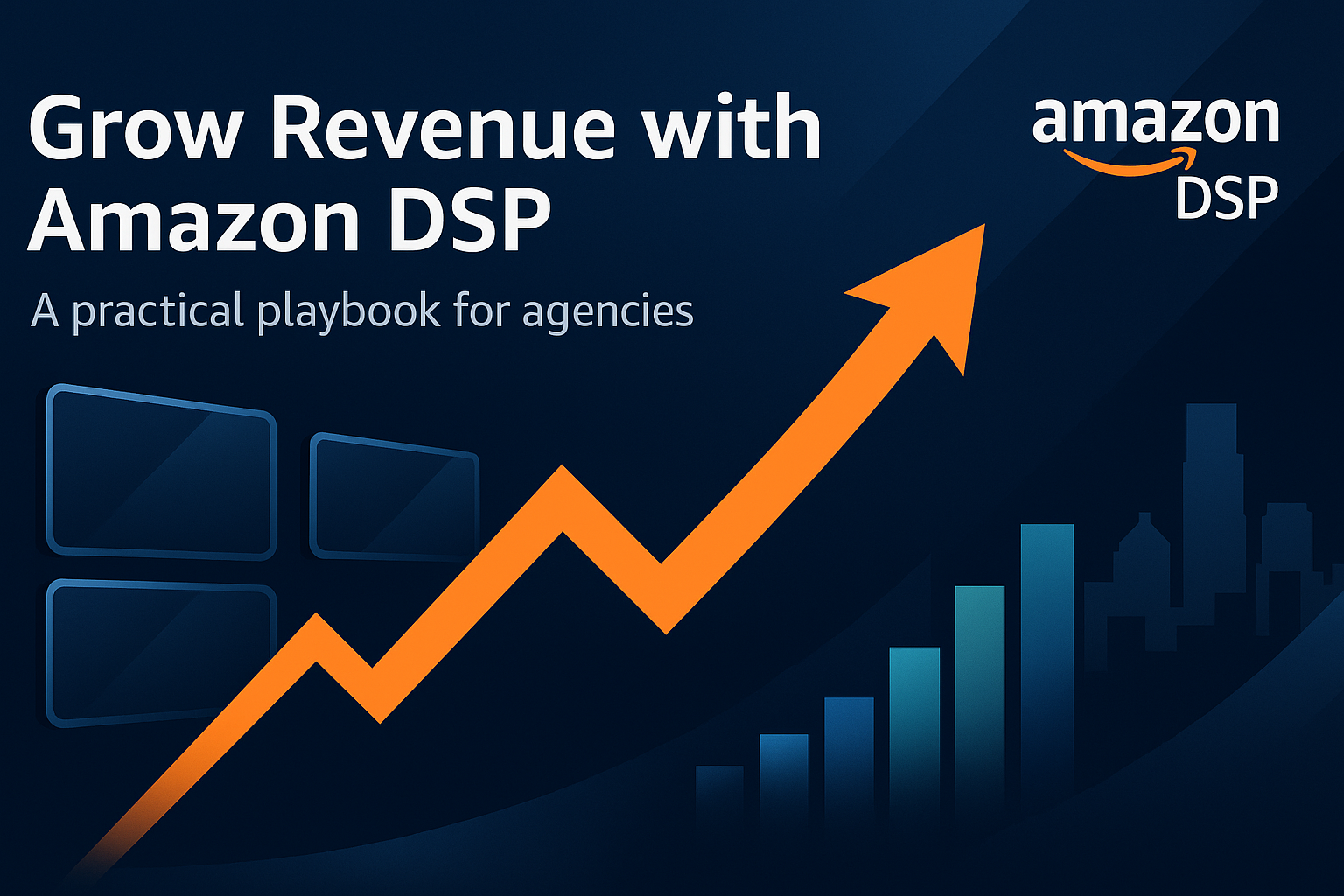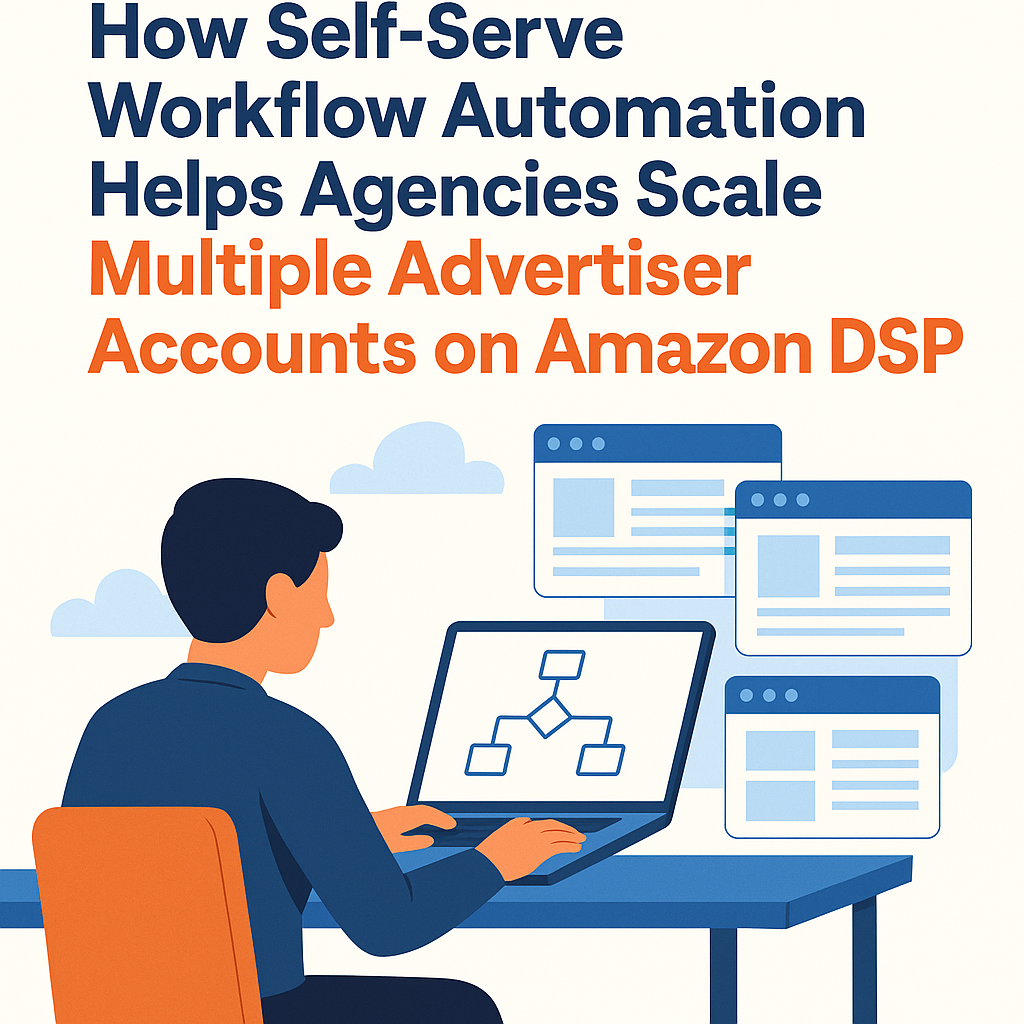How Ad Agencies Can Grow Revenue With Amazon DSP
If you run a media agency, Amazon DSP (ADSP) can be more than “another channel.” It can be a revenue engine that deepens client value, differentiates your offer, and creates repeatable margins—without bloated fees. Here’s a practical playbook you can ship this quarter.
Why Amazon DSP is a revenue engine
- Deterministic audiences: Retail and streaming signals (shopping, content, device graph) let you build segments your competitors can’t easily match.
- CTV at scale: Access premium supply (including Prime Video inventory plus a wide open-web footprint) with performance controls and transparent fees.
- Measurement that lands with the C-suite: Clean, outcome-oriented reporting through Amazon Marketing Cloud (AMC) and native conversion metrics.
- Deal flexibility: Use PMPs/PGs to curate quality, then layer insights to prove incrementality and justify premium retainers.
9 revenue levers you can activate
- Strategy & Orchestration Retainers
Package quarterly audience/creative/measurement strategy. Position DSP buying as the execution layer of a broader growth plan.
Pricing idea: $3–8k/mo depending on scope and number of brands/markets. - Managed Service Fees on Media
Transparent pass-through media + a management fee tied to complexity.
Typical structures:- Tiered % of spend (e.g., 12% → 8% as monthly media scales)
- Flat fee per market or per line of business for local brands (predictable for clients, reliable for you)
- Outcome-Based Upside
Add bonuses when you exceed agreed KPIs (CPL, CPV, qualified site actions, new-to-brand sales where applicable).
Example: Base 8% of spend + 10% bonus on incremental conversions over target. - Audience Products
Turn your know-how into SKUs: “In-Market Auto Buyers,” “High-Intent Luxury Shoppers,” “Sports Streamers,” etc. Package the build + upkeep as a monthly fee.
Deliverable: Document the logic (signals, recency, exclusions), refresh cadence, and expected reach. - Creative & Dynamic Production
Monetize concepting and versioning for CTV, OLV, and display. Pair audience insights with ad sequencing and creative testing.
Offer: “CTV Starter Kit”—script, :15/:30 cuts, three display sets, and a 60-day test plan. - Measurement & AMC Analytics
Sell a standalone analytics layer: dashboards, cohort analysis, pathing, overlap studies, and post-campaign reads with plain-English insights.
Pricing idea: $1.5–5k/mo per brand, plus project fees for deep dives. - Curated Deals & Supply Operations
Build a private marketplace library (brand-safe, genre/vertical curated). Charge a curation fee for access and maintenance. - Training & Enablement
Workshops for client teams: “CTV 101,” “AMC for Marketers,” “Creative for Retail Media.” Great for enterprise retention and land-and-expand. - Cross-Channel Bundles
Package Amazon DSP with search/retail media, audio, and on-site conversion optimization. The more surfaces you influence, the stickier the relationship—and the better your margins.
Simple packaging you can copy
Starter (Pilot, 60–90 days)
- $15–40k media; 12–15% management fee
- 1 audience package, 1 creative package, weekly reporting, 1 post-mortem with insights → “Go/No-Go” plan
Growth (Always-On)
- $40–150k+/mo media; 8–12% management
- 3–5 curated deals, AMC dashboard, quarterly tests, creative refresh every 6–8 weeks
Prime (Enterprise/Franchise)
- Multi-market, multi-brand; blended 6–10% + outcome bonus
- Custom audience factory, MMM/MTA support, content partnerships, training program, exec QBRs
Pro tip: publish these as productized pages with fixed inclusions and add-ons. It shortens sales cycles.
Your first 90 days (operations checklist)
Week 1–2: Foundation
- Confirm measurement (pixels, conversion events, offline match process).
- Draft 3 audience hypotheses and 2 creative angles per audience.
- Build a PMP/PG plan (brand safety, frequency, dayparting, supply tiers).
Week 3–4: Launch
- Ship minimal viable structure: Prospecting, Mid-funnel, Remarketing.
- Set learning budgets and guardrails (frequency, pacing, reach goals).
Week 5–8: Prove it
- Run at least two controlled tests (creative message, audience overlap, deal quality).
- Publish a one-page “Insights Memo” bi-weekly: what changed, what it delivered, what you’re changing next.
Week 9–12: Lock in
- AMC readout with 3 executive-level insights and a 120-day roadmap.
- Present the Growth or Prime package as the logical next step.
The revenue math (keep it honest, keep it simple)
- Gross margin target (services): 55–70% on fees.
- Blended margin target (media + fees): 25–40% depending on mix.
- Capacity planning: 1 strategist + 1 trader comfortably manage ~$250–400k/mo across 3–6 accounts if creative and analytics are resourced.
What to measure (so you can sell the win)
- Reach & frequency quality: Unique reach, capped frequency by funnel.
- Incremental actions: New-to-brand site visitors, qualified pageviews, store locator usage, lead form starts/completes, add-to-carts (where relevant).
- CTV effectiveness proxies: Completion rate, cost per completed view, post-exposure actions.
- Overlap & pathing: Audience deduplication, contribution to conversions, time-to-convert.
- Financials: Media efficiency (eCPM/eCPCV), cost per qualified action, and outcome vs. target.
Sales motion that works
- Target: Brands overspending on traditional TV/OLV or stuck with opaque vendor fees.
- Discovery questions:
- What % of video budget is truly connected TV vs repackaged OLV?
- How are audiences built today? What signals are missing?
- What is your current fee structure and what feels opaque?
- Which business outcomes matter to your CFO this quarter?
- Pitch arc: Show how deterministic targeting + curated CTV supply + outcome reporting replaces waste and uncertainty.
- Offer: A 90-day pilot with a fixed fee, two experiments, and an AMC readout.
- Close: Present the 12-month plan with a performance-based bonus.
Risks to manage (and how)
- Creative fatigue: Plan refreshes every 6–8 weeks; pre-approve alternates.
- Over-frequency: Enforce caps by funnel and device; rotate supply.
- Attribution confusion: Align on a primary outcome and a short list of directional KPIs. Use AMC to answer “what moved”—not to chase perfect attribution.
- Fee skepticism: Publish fees plainly; separate media from services and show how each drives outcomes.
Reusable assets you should build once
- Audience cookbook (recipes + refresh rules)
- Deal library (PG/PMP descriptions, when to use, expected reach)
- AMC report templates (tests, outcomes, executive summary)
- CTV creative guide (hooks, length, sequencing)
- One-page “Pilot Program” and a 12-slide pitch deck



Comments